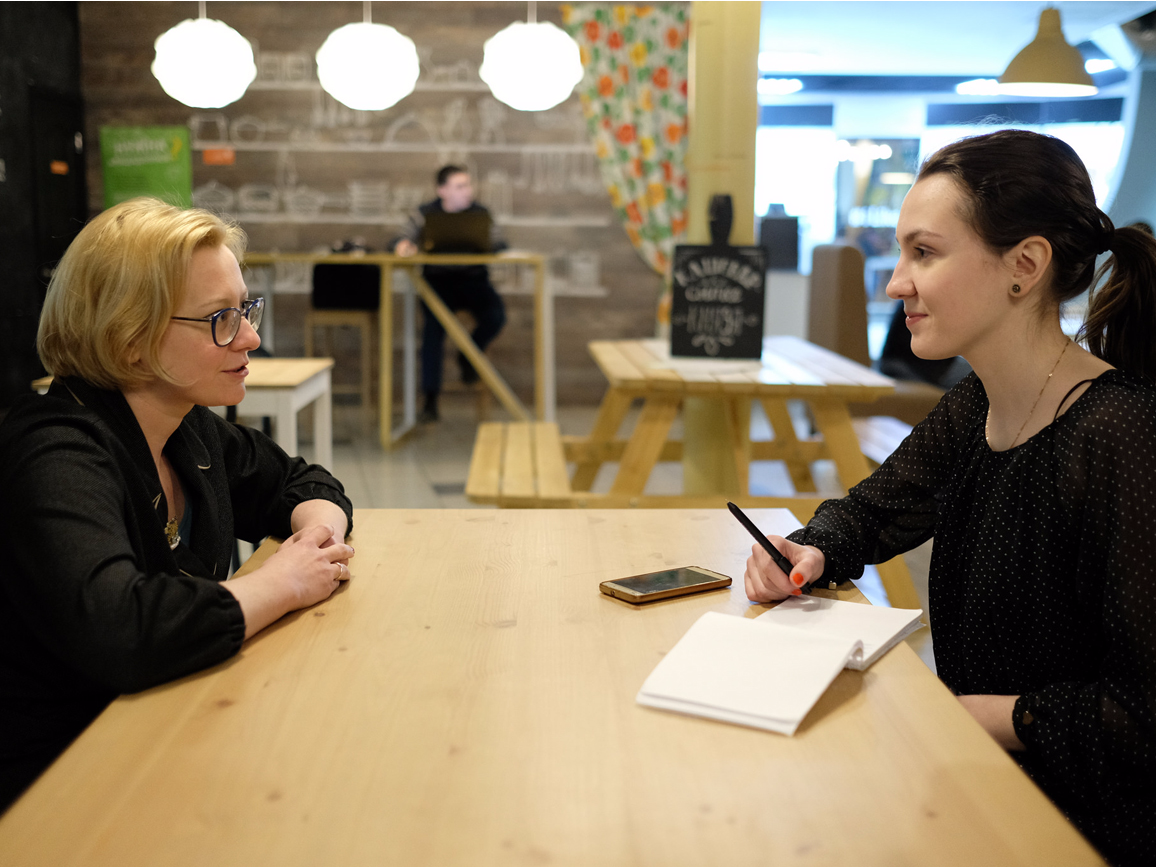
Making a great first impression is crucial — not only in your professional life, but socially, too. But first impressions are not always easy, and if you fail to catch someone's attention, it may be game over for you.
Check out these tips to help you always make a lasting impression on someone you meet.
Put your hands up!
I’m a TED Talk junkie, and I’ve often wondered why some talks generate enormous traffic, and some fall flat, even if the talks themselves are equally interesting. Could it have to do with first impressions ?
To find out, I designed an experiment. I had a team of coders analyze hundreds of hours of TED Talks, looking for differences between the least and most viewed videos. We counted hand gestures and measured vocal variety, smiling and body movement.
Be firm. How can you tell if a peach is ripe?You squeeze until you feel a tiny bit of resistance. Same goesfor people. Squeeze until you feel their muscles tighten, andthen stop. And never give someone a limp hand — it’s deadly forrapport.
Related: 8 Handshakes That Make Unforgettably Bad FirstImpressions
Stand like a winner
Projecting an air of confidence is absolutely critical whenmeeting someone new. Why? It’s simple. Because, as humans, wewant to be associated with winners, not losers. We want to beled by winners, not losers. And in the first few seconds of aninteraction, we’re looking for indications of confidence. We’retrying to decide if the person we are speaking with looks likea winner or a loser. And that person is looking for the exactsame thing in us.
So what does a winner look like? Researchers Jessica Tracy andDavid Matsumoto wanted to find out. To do this, they comparedhow various sighted and blind Olympic athletes behaved afterthey won or lost a race. Did those people display the sameforms of pride and shame?
The answer was yes — across cultures, and regardless of whetheran athlete had ever seen other athletes with their own eyes,the behavior of winning and losing was identical. Winnerstypically raise their arms over their heads, expand theirchests and tilt their heads up toward the sky. Losers bowtheir heads, slump their shoulders, and pin their arms tightlyto their sides.
The fact that athletes instinctively use the same body languageshows us how innately programmed we are to non-verballybroadcast victory and defeat. When we’re proud, we want peopleto notice us, so we take up space. When we feel defeated, wetry to deflect attention by taking up as little space aspossible.
Here’s what we found: The most popular TED Talkers used hand gestures to instantly build trust with their audience. The most popular used an average of 465 hand gestures (yes, our coders counted every single one). The least popular TED Talkers used an average of 272 hand gestures. And TED superstars Temple Grandin, Simon Sinek and Jane McGonigal topped the charts with more than 600 hand gestures in just 18 minutes.
Related: How to Master the Art of the First Impression
This effect isn’t specific to TED Talks. More than 30 years ago, researchers Robert Gifford, Cheuk Fan Ng and Margaret Wilkinson found that, among other aspects, job candidates who used more hand gestures in their interviews were more likely to get hired.
Why do hand gestures have such an impact? They can show intention. Think back to the caveman days. When a stranger approached our caveman ancestors, the best way to tell if the stranger had good or bad intentions was to look at their hands. Were they carrying a rock or a spear? Then as the stranger introduced themselves, our ancestors watched their gestures to make sure they weren’t going to reach out and attack or steal precious belongings.
My theory: Even though we aren’t often subjected to physical harm today, this ancient survival mechanism remains.
When someone can see your hands, they feel more at ease and are more likely to befriend you. I have found that the absolute easiest thing you can do to improve your first impression is to keep your hands visible. So when you walk into a room or are waiting to meet someone, keep your hands out of your pockets. Pockets are murderers of rapport. Don’t let desks, purses or laptops block them, either.
And never, ever skip a handshake. The moment we have skin-to-skin touch with someone, our body produces something called oxytocin. Researcher Paul Zak discovered the power of this little hormone to facilitate trust. In one experiment, he was able to manipulate the trust of participants simply by giving them a dose of oxytocin. Think about that. They don’t call it “the connection hormone” for nothing.
How to give a perfect handshake
Keep it dry. Nothing is worse than aslimy palm. If you’re at a party, wrap some extra napkinsaround your drink. The innermost will absorb condensation; therest are your wipe.
Keep it vertical. Offering your palm up isconsidered by some to be a submissive or weak gesture, whereasforcing someone into the palm-up position by putting your handout palm down can be seen as domineering.
Be firm. How can you tell if a peach is ripe?You squeeze until you feel a tiny bit of resistance. Same goesfor people. Squeeze until you feel their muscles tighten, andthen stop. And never give someone a limp hand — it’s deadly forrapport.
Related: 8 Handshakes That Make Unforgettably Bad FirstImpressions
Stand like a winner
Projecting an air of confidence is absolutely critical whenmeeting someone new. Why? It’s simple. Because, as humans, wewant to be associated with winners, not losers. We want to beled by winners, not losers. And in the first few seconds of aninteraction, we’re looking for indications of confidence. We’retrying to decide if the person we are speaking with looks likea winner or a loser. And that person is looking for the exactsame thing in us.
So what does a winner look like? Researchers Jessica Tracy andDavid Matsumoto wanted to find out. To do this, they comparedhow various sighted and blind Olympic athletes behaved afterthey won or lost a race. Did those people display the sameforms of pride and shame?
The answer was yes — across cultures, and regardless of whetheran athlete had ever seen other athletes with their own eyes,the behavior of winning and losing was identical. Winnerstypically raise their arms over their heads, expand theirchests and tilt their heads up toward the sky. Losers bowtheir heads, slump their shoulders, and pin their arms tightlyto their sides.
The fact that athletes instinctively use the same body languageshows us how innately programmed we are to non-verballybroadcast victory and defeat. When we’re proud, we want peopleto notice us, so we take up space. When we feel defeated, wetry to deflect attention by taking up as little space aspossible.
Now, as much as I want you to look like a winner, thetraditional winner’s pose is a bit much for everydayinteractions. Instead, I use something I call the launchstance. This is a slightly toned-down version of the winner’sposture: Keep your shoulders down and back; aim your chin,chest and forehead straight in front of you or slightlyup; keep space between your arms and torso — not too much —and, again: Keep those hands out of your pockets.
Related: 8 Great Tricks for Reading People's BodyLanguage
Look ’em straight in the eye
Once we decide someone is a winner, we want to know if weshould align with them — if, so to speak, they should be on ourteam. This is the differentiator between a good firstimpression and a great one. So we ask ourselves questions:Does this person like me? Would this person respect myopinion? Will this person include me? Will this person helpme? If the answers are no, we’ll never warm to thatperson.
And if you’re the one being evaluated, how do you communicatethat you’re worth aligning with? Easy: eye contact.
One of the most powerful examples of eye contact is in a videodone by activist Jae West and her team at Liberators International, an organization thataims “to coordinate, record and distribute monthly globalacts of freedom,” and whose YouTube channel is filled with manydaring acts of kindness and awareness-raising.
The video is called “The World’s Biggest Eye Contact Experiment.”In this video, strangers are asked to participate in one minuteof sustained eye contact with another stranger. “We weredefinitely nervous going into it,” says West. “It’s quiteconfronting to stare a stranger in the eye and allow yourselfto be vulnerable.”
The results were overwhelming. More than 100,000 peopleparticipated in the experiment in 156 cities around the world.After just one minute of eye contact, stranger after strangerended their moment in tears, hugs and astonishment.
Why is eye contact so powerful? Like a handshake, we’reprogrammed to interpret the right amount of eye contact as anonverbal signal of goodwill — because when you like someone,you look at them more. Just don’t overdo it. Body languageexperts Barbara and Allan Pease say the ideal is to looksomeone in the eye 60 to 70 percent of the time you’reinteracting with them. If you do far less than that, you canappear timid and nervous. More, and you’re off-putting. But inthat sweet spot, you’re making a connection that lasts.
Related: 15 Body Language Secrets of SuccessfulPeople
How to move
What do you say when you don’t say anything? Lillian Glass,Ph.D., a body language expert and communications consultant,tells us six things to watch for.
1. Stop fidgeting. “You’ve got to eliminatetapping your fingers, shaking your leg, tapping your feet,”she says. Those are signals that you’re insecure anduncomfortable. And appearing insecure makes others lessinclined to engage with you.
2. Be sure to lean in. “If you’re leaningaway from someone in conversation, that’s a huge body codesaying, ‘I don’t want anything to do with you.’ Lean into theconversation to show your comfort level.”
3. Watch the face. Your autonomic nervoussystem kicks into overdrive if you’re feeling nervous orlying, making you itchy. Pulling on your nose or scratchingyour cheek can signal deception, while chewing on a pen cap“gives off a sense of being judgmental.”
4. Easy on the blinking. When we’re nervous,we blink more than usual, Glass says. “Your nerves are firingrapidly, your subconscious is working overtime and youreyes dry up to compensate.”
5. Mind the goods. People tend tounconsciously cover their genitals when they stand up. “Yournatural human instinct is to protect the most vulnerableparts of the body,” Glass says. But doing so “weakens yourposition and makes you look insecure.”
6. Flail = fail. “Sometimes if you don’tknow how to use your hands properly, you start flailing allover the place,” Glass says. But don’t be too stiff. “Youhave to flow, be easy at the wrist and the elbow, which willshow you have command of the situation.”
Trash the script
Sometimes we’re lazy or plain afraid of tackling new topics insocial situations. I get it. We have our scripts— Where are you from? What do you do? — andwe stick to them. But what’s the point of following nearlyidentical social scripts every time you talk to someone? What’sthe point of trying to talk to a new client if the conversationis so boring they won’t remember it anyway?
Good conversation has tons of sparks: little bursts of pleasurewe remember. In the brain, sparks are marked by dopamine, aneurotransmitter released when we feel pleasure. Importantly,that little chemical also helps your long-term memory. “You canthink of it like a Post-it Note that reads, ‘Remember this!’”says molecular biologist Dr. John Medina. “Getting one’s brainto put a chemical Post-it Note on a given piece of informationmeans that information is going to be more robustly processed.”
In other words, being memorable boils down to inducing chemicalpleasure. When you produce dopamine during a conversation, younot only give your partner more enjoyment; you are alsoassigned more significance, which increases your memorability.
How do you trigger dopamine? By asking fresh questions thatignite new ideas, introducing topics we hadn’t thought about,and stimulating in-depth discussions.
In 2016, to better understand this, my company teamed up withthe organizations Mercy Corps, Society for InformationManagement and Girls Inc. We randomly partnered more than300 participants and gave each pair seven slips of paper. Oneach slip, one of the following questions appeared:
What’s your story?How are you?What was the highlight of your day?What do you do?Has anything exciting come up in your life?What brings you here?What personal passion project are you working on?Once everyone was seated, we ran them through what wasessentially the networking version of speed-dating. When werang a bell, they picked up one of the slips and had aconversation based on it. After three minutes, we rang anotherbell and they rated the quality of that conversation — from 1(for boring) to 5 (for stellar). We wanted to see whichsubjects would rank the highest.
And here are the results, in order from most to leastinteresting. 1. What was the highlight of your day? 2. Whatpersonal passion project are you working on? 3. Has anythingexciting come up in your life? 4. What’s your story? 5. Whatbrings you here? 6. What do you do? 7. How are you?
Notice that the least effective sparkers are the ones peopletend to use the most. Coincidence? No. We stick to socialscripts out of habit. We use the same dull conversationstarters over and over again because they are in our comfortzone. But we need to stop that. Nothing spark-worthy happens inyour comfort zone.
All this advice really drives toward one thing: When we meetnew people, we have to quickly decide if we want them in ourlives. First impressions are a survival mechanism, a way toinstinctively react to external stimuli and decide whether youshould stay or flee. If you want someone to stay, you need toquickly win them over. Keep your hands visible, make eyecontact, stand like a winner and try non-typicalconversation sparkers. That’s how you’ll turn strangers intoacquaintances, acquaintances into friends and prospectsinto clients. That’s how you become memorable.
Related: 9 Phrases Smart People Never UseIn Conversation
How to make eye contact
It’s imperative to making a strong connection — but how much istoo much? Here are three ways to perfect your gaze.
1. Hold it. Eye contact during aconversation increases brain stimulation and, as a result,recall of the conversation. But it doesn’t take much: A 2006study found that maintaining eye contact just 30 percent ofthe time significantly increased a listener’s memory.
2. But not for too long. Research shows thatholding eye contact longer than three seconds without takinga break can be interpreted as aggressive, causing listenersto feel defensive and resistant to what you’re saying.
3. And take breaks. Eye contact and wordgeneration share cognitive resources, according to a 2016study. That means maintaining too much eye contact can sapyour brain and impact your ability to verbally respond.
Related: 8 Great Tricks for Reading People's BodyLanguage
Look ’em straight in the eye
Once we decide someone is a winner, we want to know if weshould align with them — if, so to speak, they should be on ourteam. This is the differentiator between a good firstimpression and a great one. So we ask ourselves questions:Does this person like me? Would this person respect myopinion? Will this person include me? Will this person helpme? If the answers are no, we’ll never warm to thatperson.
And if you’re the one being evaluated, how do you communicatethat you’re worth aligning with? Easy: eye contact.
One of the most powerful examples of eye contact is in a videodone by activist Jae West and her team at Liberators International, an organization thataims “to coordinate, record and distribute monthly globalacts of freedom,” and whose YouTube channel is filled with manydaring acts of kindness and awareness-raising.
The video is called “The World’s Biggest Eye Contact Experiment.”In this video, strangers are asked to participate in one minuteof sustained eye contact with another stranger. “We weredefinitely nervous going into it,” says West. “It’s quiteconfronting to stare a stranger in the eye and allow yourselfto be vulnerable.”
The results were overwhelming. More than 100,000 peopleparticipated in the experiment in 156 cities around the world.After just one minute of eye contact, stranger after strangerended their moment in tears, hugs and astonishment.
Why is eye contact so powerful? Like a handshake, we’reprogrammed to interpret the right amount of eye contact as anonverbal signal of goodwill — because when you like someone,you look at them more. Just don’t overdo it. Body languageexperts Barbara and Allan Pease say the ideal is to looksomeone in the eye 60 to 70 percent of the time you’reinteracting with them. If you do far less than that, you canappear timid and nervous. More, and you’re off-putting. But inthat sweet spot, you’re making a connection that lasts.
Related: 15 Body Language Secrets of SuccessfulPeople
How to move
What do you say when you don’t say anything? Lillian Glass,Ph.D., a body language expert and communications consultant,tells us six things to watch for.
1. Stop fidgeting. “You’ve got to eliminatetapping your fingers, shaking your leg, tapping your feet,”she says. Those are signals that you’re insecure anduncomfortable. And appearing insecure makes others lessinclined to engage with you.
2. Be sure to lean in. “If you’re leaningaway from someone in conversation, that’s a huge body codesaying, ‘I don’t want anything to do with you.’ Lean into theconversation to show your comfort level.”
3. Watch the face. Your autonomic nervoussystem kicks into overdrive if you’re feeling nervous orlying, making you itchy. Pulling on your nose or scratchingyour cheek can signal deception, while chewing on a pen cap“gives off a sense of being judgmental.”
4. Easy on the blinking. When we’re nervous,we blink more than usual, Glass says. “Your nerves are firingrapidly, your subconscious is working overtime and youreyes dry up to compensate.”
5. Mind the goods. People tend tounconsciously cover their genitals when they stand up. “Yournatural human instinct is to protect the most vulnerableparts of the body,” Glass says. But doing so “weakens yourposition and makes you look insecure.”
6. Flail = fail. “Sometimes if you don’tknow how to use your hands properly, you start flailing allover the place,” Glass says. But don’t be too stiff. “Youhave to flow, be easy at the wrist and the elbow, which willshow you have command of the situation.”
Trash the script
Sometimes we’re lazy or plain afraid of tackling new topics insocial situations. I get it. We have our scripts— Where are you from? What do you do? — andwe stick to them. But what’s the point of following nearlyidentical social scripts every time you talk to someone? What’sthe point of trying to talk to a new client if the conversationis so boring they won’t remember it anyway?
Good conversation has tons of sparks: little bursts of pleasurewe remember. In the brain, sparks are marked by dopamine, aneurotransmitter released when we feel pleasure. Importantly,that little chemical also helps your long-term memory. “You canthink of it like a Post-it Note that reads, ‘Remember this!’”says molecular biologist Dr. John Medina. “Getting one’s brainto put a chemical Post-it Note on a given piece of informationmeans that information is going to be more robustly processed.”
In other words, being memorable boils down to inducing chemicalpleasure. When you produce dopamine during a conversation, younot only give your partner more enjoyment; you are alsoassigned more significance, which increases your memorability.
How do you trigger dopamine? By asking fresh questions thatignite new ideas, introducing topics we hadn’t thought about,and stimulating in-depth discussions.
In 2016, to better understand this, my company teamed up withthe organizations Mercy Corps, Society for InformationManagement and Girls Inc. We randomly partnered more than300 participants and gave each pair seven slips of paper. Oneach slip, one of the following questions appeared:
What’s your story? How are you? What was the highlight of your day? What do you do? Has anything exciting come up in your life? What brings you here? What personal passion project are you working on?Once everyone was seated, we ran them through what wasessentially the networking version of speed-dating. When werang a bell, they picked up one of the slips and had aconversation based on it. After three minutes, we rang anotherbell and they rated the quality of that conversation — from 1(for boring) to 5 (for stellar). We wanted to see whichsubjects would rank the highest.
And here are the results, in order from most to leastinteresting. 1. What was the highlight of your day? 2. Whatpersonal passion project are you working on? 3. Has anythingexciting come up in your life? 4. What’s your story? 5. Whatbrings you here? 6. What do you do? 7. How are you?
Notice that the least effective sparkers are the ones peopletend to use the most. Coincidence? No. We stick to socialscripts out of habit. We use the same dull conversationstarters over and over again because they are in our comfortzone. But we need to stop that. Nothing spark-worthy happens inyour comfort zone.
All this advice really drives toward one thing: When we meetnew people, we have to quickly decide if we want them in ourlives. First impressions are a survival mechanism, a way toinstinctively react to external stimuli and decide whether youshould stay or flee. If you want someone to stay, you need toquickly win them over. Keep your hands visible, make eyecontact, stand like a winner and try non-typicalconversation sparkers. That’s how you’ll turn strangers intoacquaintances, acquaintances into friends and prospectsinto clients. That’s how you become memorable.
Related: 9 Phrases Smart People Never UseIn Conversation
How to make eye contact
It’s imperative to making a strong connection — but how much istoo much? Here are three ways to perfect your gaze.
1. Hold it. Eye contact during aconversation increases brain stimulation and, as a result,recall of the conversation. But it doesn’t take much: A 2006study found that maintaining eye contact just 30 percent ofthe time significantly increased a listener’s memory.
2. But not for too long. Research shows thatholding eye contact longer than three seconds without takinga break can be interpreted as aggressive, causing listenersto feel defensive and resistant to what you’re saying.
3. And take breaks. Eye contact and wordgeneration share cognitive resources, according to a 2016study. That means maintaining too much eye contact can sapyour brain and impact your ability to verbally respond.
Read the original article on Entrepreneur. Copyright 2017. Follow Entrepreneur on Twitter.




